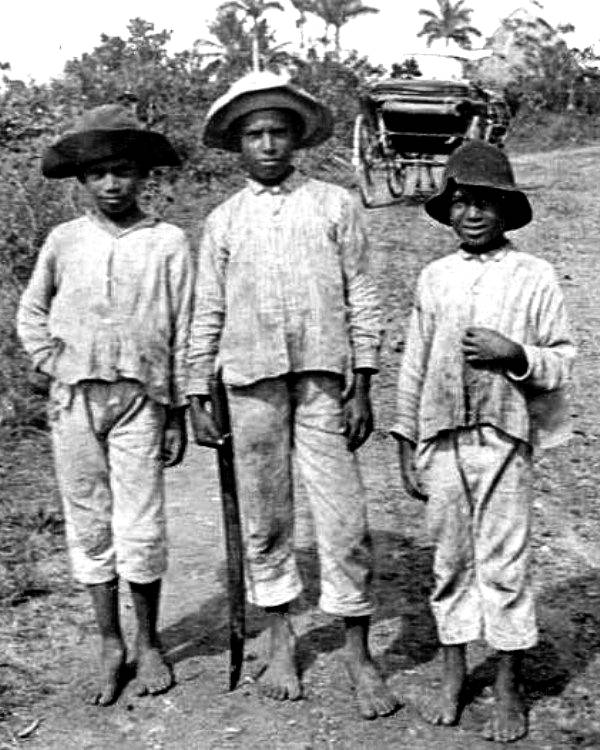
Cuban Sugar Industry: Economic Situation (1899)

Figure 1.--These unidentified boys were photographed during 1899 in the countryside near Havana. The boys are wearing the classic campesino clothing. They do notlike former slaves. It is possible that their father or fathers owned small plots and may have worked on plantations. While the boys look poor, they do not look hungry or malnourished. The accounts of desprrate conditions following the independence struggle may pertain more to the land-owning class than the rural peasantry. Notice the machete the oolder boy is holding.
|
|
Cuba was devestated by the independence struggle. The country's sugar industry, the most important economic acivity, was devestated. In Pinar del Río Province only 7 of 70 sugar mills were still operating. In Las Villas Province only 73 of 332 sugar mills were undamaged. By the time the Americans landed (1898), less than 20 percent or 207 of Cuba's 1,100 sugar mills were undamaged. [Pérez Hispanic.] The Cuban economy was in a shambles and most of the vital sugar industry shut down. The Mayor of Nueva Paz in Havana Province describes the situation. "The lands of this muncipality represents a taxable income of $236,000 [in 1999 dollars], but all are abandodned. Even those who were not completely ruined are in an unproductive state." Another official, Mayor Julio Domínguez of Cruzes in Santa Clara Province wrote, "At the commencement of the year 1899, no lands in this district were under cultivation, with the exception of a few very small farmssurrounding the towns, devoted to the cultivation of vegetables and other produce for the sustenanceof their owners. Misery, hunger, sickness and generaldiscontent prevailed among the people. [Pérez, Lords, p. 72.] We suspect that many of these assessments were from upper- and middle-class Cubans, commonly assocoated with the Colons and important land owners. The rural peasantry may not be in as desperate circumstances. They could grow vegetables and perhaps raise a few chickens and even a hog, Unk\like the landowners, they were no accustomed to an affluent life style. They may jave had trouble finding work, but they could produce food.
Sources
Pérez, Louis A. Jr. Hispanic American Historical Review (1985).
Pérez, Louis A. Jr. Lords of the Mountain: Social Banditry and Peasant Protest in Cuba, 1878-1918
HBC

Navigate the Boys' Historical Clothing Web Site:
[Return to the Main Cuban sugar industry page]
[Return to the Main sugar page]
[Return to the Main food page]
[Return to the Main agricultural page]
[Return to the Main Economics page]
[Return to the Main Cuban history page]
[Introduction]
[Activities]
[Biographies]
[Chronology]
[Clothing styles]
[Countries]
[Bibliographies]
[Contributions]
[FAQs]
[Glossaries]
[Images]
[Registration]
[Tools]
[Boys' Clothing Home]
Created: 5:25 AM 10/1/2012
Last updated: 12:06 AM 10/3/2012



